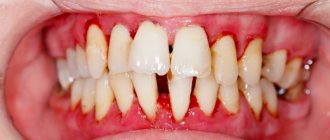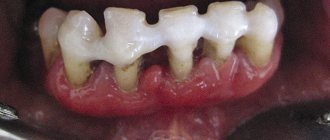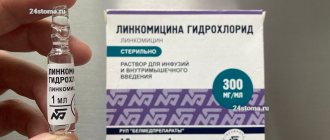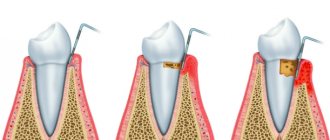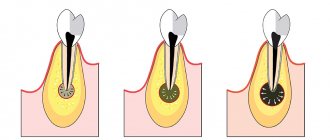How does periodontitis develop?
Periodontitis is a chronic inflammation of periodontal tissues that develops for a number of reasons. The disease can occur due to incomplete removal of plaque, which leads to infection of periodontal tissues. Possible causes also include allergic reactions to medications, trauma to periodontal tissue, bite defects and various diseases of the body that cause hormonal and metabolic disorders.
Periodontitis has 4 stages of development:
1. Initial – symptoms are absent or mild. At this stage, bad breath often appears, heavy plaque on the enamel, the color of the gums changes, and slight bleeding is observed.
2. At the second stage of periodontitis, the interdental septa decrease by 1/4 - 1/3 of the root. Symptoms become more pronounced: the formation of tartar, deformation and swelling of the gums, pain, increased interdental space, slight exposure of the root, etc. At this stage, periodontal “pockets” are filled with purulent contents, which can also be manifested by general fatigue and increased body temperature.
3. 3rd degree progressive, the root opens 1/2. There is deformation of the teeth and gums, severe bleeding, instability of the teeth, pain when chewing and pressing on the crown. Immediate treatment is required. Flap surgery on gums is recommended
.
4. The last stage of periodontitis is irreversible. Treatment is possible only with complete removal of damaged teeth followed by prosthetics.
Indications and contraindications
Surgical methods for the treatment of periodontal diseases are used in cases where changes in the structure of tissues require appropriate intervention. Factors that serve as characteristic indications include:
- Significant deepening of the bone pocket - over 5 mm;
- Detection of an increase in the volume of granulations;
- Changing the natural structure of interdental tissues;
- Diagnosis of purulent abscesses and inflamed areas;
- Determination of pathologies in the development and position of tissues;
- The presence of significant space after cleaning the periodontal pocket;
- Ineffectiveness of previously prescribed conservative treatment methods.
Factors limiting surgical intervention include absolute and relative contraindications. In the first case, surgery is excluded due to the presence of serious diseases (oncology, chronic pathologies); in the second, it can be performed after local problems have been eliminated.
Kinds
Surgical intervention is divided into two main groups:
- cleaning gum pockets;
- correction of various defects.
The first group includes the following types of surgical intervention:
- curettage using special instruments, carried out when gum pockets are exposed, provides for complete cleaning, removal of all foreign matter and infected tissue;
- gingivotomy is carried out in the form of cleaning, for which the doctor makes a vertical measurement, followed by open curettage with removal of infected areas;
- gingivectomy is performed with horizontal removal along the gum contour; the operation can be performed on the lingual or vestibular side;
- gingivoplasty - edge modeling in order to recreate the natural contour and remove affected areas, can be combined with bone augmentation or curettage;
- The flap technique is performed with excision of lesions and fixation of the flap in the spaces between the teeth;
- bone grafting compensates for the lack of volume and is indicated as one of the preparation stages for installing implants;
- electrosurgery involves the use of a special electrocoagulator, which eliminates infection and allows you to quickly simulate the edge, accelerating the healing period.
The second group of interventions includes the following types of operations;
- vestibuloplasty to deepen the vestibule of the oral cavity, expanding, deepening the area between the teeth and lips;
- plastic surgery of cords and frenulums is usually performed in childhood; it eliminates a number of problems in the future; if it has not been performed in a child, it is recommended for adults at any age;
- closing the recession to reduce soft tissue volume.
